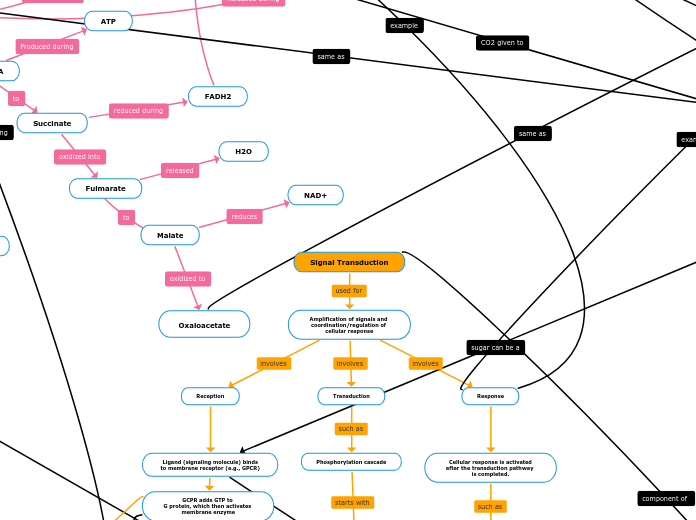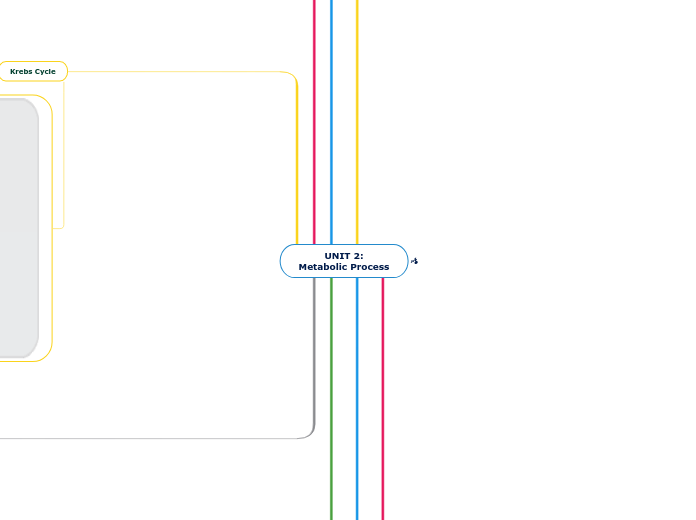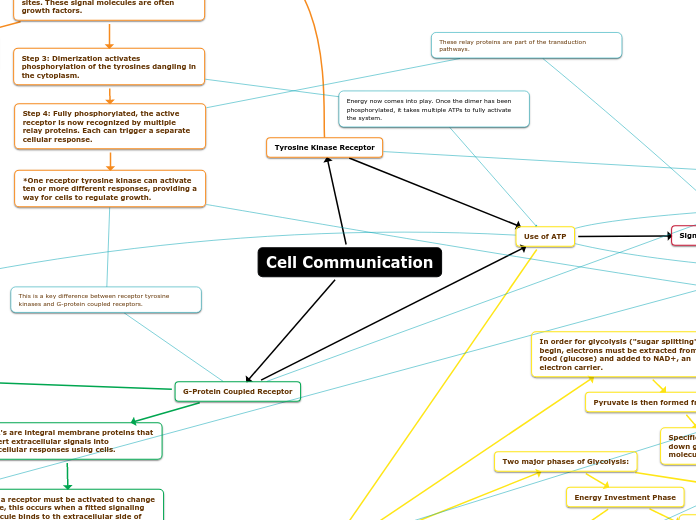Kinases are inactivated by
protein phosphatases which
remove a phosphate group
Citric acid cycle begins
Lactic Acid
Alcohol Fermentation
Anerobic respiration
transport protein - ATP Synthesis
concentration gradient
Chemiosmosis ATP Synthesis
Inner mitochondrial membrane
Electron Transport Chain
FADH2
H2O
Oxaloacetate
Malate
Fulmarate
Succinate
Succinyl CoA
a-ketoglutarate
Isocitrate
Citrate
Acetyl CoA
2 H+
2 NADH
2 ATP
2 H2O
2 Pyruvate
Water/H2O
Pyruvate
NADH
Net
Protons
Electrons
NAD+
Phosphate
ADP
ATP
Glucose
Energy Payoff Phase
Oxidative Phosphorylation
Pyruvate Oxidation
Energy Investment Phase
Glycolysis
Substrate level phosphorylation
Cellular Respiration
Cell Signaling
Releasing a signal
reception
transduction
response
Receptors
target cell that receives the signal molecule
Intracellular receptors:in cytoplasm & nuclues
steroid hormone aldosterone
Membrane receptors
includes
Ion channel receptor
when a signal molecule binds to the receptor, the gate allows a specific ion like sodium or calcium through the channel in the receptor
movement of ions through these channels may change the voltage across membranes
this would trigger action potential
Tyrosine kinase receptor
Polypeptide on dimerization functions as a kinase
it takes a phosphate group from ATP and adds it to another polypeptide
G protein linked receptor
signal molecule binds to the GPCR
slight alteration in the shape of GCPR allows for the G protein to bind to it
GDP is replaced with GTP on the G protein
G protein with GTP bound to it is active and it can now activate a nearby enzyme
all of the above steps occur in reception
Long distance signaling
Hormonal Signaling
Local signaling
Synaptic signaling
Paracrine signaling
Physical Contact
Plasmodesmata (plant cells)
Gap Junction (animal cells
Photosynthesis
C4-Cycle
Spatial separation of steps
CO2 enters the mesophyll cell through PEP carboxylase
Oxaloacetate(4C) is formed
malate(4C) is formed
Bundle Sheath cell
Pyruvate (3C)
PEP (3C)
CO2
calvin cycle
sugar
vascular tissue
CAM Cycle
Temporal separation of steps
Calvin Cycle
CO2 is introduced due to Rubisco
Phase 1 Carbon Fixation
as CO2 binds with rubisco it creates a short lived intermediate
after the short lived intermediate 3-Phosphoglycerate is made
with the introduction of 6 ATP and excretion of ADP 1,3-Bisphoglycerate is made.
with the introduction of 6 NADPH and the excretion of NADP+P we enter a new phase
Phase 2 Reduction
Glyceraldehyde-3-phosphate
(G3P) is created by phase 1 and is the main sugar used by plants
Phase 3 Regeneration of the CO2 acceptor
3 ATP are introduced cause 3 ADP to leave
this creates Ribulose bisphosphate (RuBP)
NADP+P
Light Reaction
Photosystem II(P680)
light and water enter the complex
electrons from water are attached to the chlorophyll as protons and O2 are excecated out. light then causes the electrons to jump to an excited state
as the electrons jump to an excited state they are accepted by the primary acceptor
the electrons then go out a electron transport chain causing ATP to be released. the chain consist of plastoquinone (Pq), Cytochrome Complex,
and Plastocyanin (Pc)
Photophosphorylation: ATP from ETC
is used to pump H+ into thylakoid space.
H+ diffuses down its concentration gradient
through ATP synthase, forming more ATP.
Photosystem I(P700)
Cyclic Electron Flow-only used when the cell needs more ATP
Cytochrome Complex to the Plastocyanin creating ATP
plastocyanin then brings its energy to the chlorophyll
electrons get excited to the primary acceptor
electrons are then taken by Ferredoxin back to the Cytochrome Complex
as the electrons for the ETC enter the chlorophyll and more light exciting them they enter the primary acceptor
this causes another ETC consisting of ferredoxin (Fd) to NADP+ reductase.
NADP(+
)+ 2 H+ binds with NADP+ causing NADPH+H+ to be formed
Common relay molecule:
Cyclic AMP
AMP after it activates
the next step. Converted by
phosphodiesterase (PDE).
ATP using the enzyme
Adenylyl cyclase
Signal Transduction
Amplification of signals and
coordination/regulation of
cellular response
Response
Cellular response is activated
after the transduction pathway
is completed.
Expression of a gene
Transduction
Phosphorylation cascade
Activation of relay molecule
(small, water-soluble molecule/ion),
triggered by reception of ligand
Activation of a protein kinase 1
Activation of protein kinase 2
as protein kinase 1 transfers a
phosphate group to it
Activation of an inactive protein as
protein kinase 2 transfers a phosphate
group to it
Activated protein triggers cellular response
Reception
Ligand (signaling molecule) binds
to membrane receptor (e.g., GPCR)
GCPR adds GTP to
G protein, which then activates
membrane enzyme









